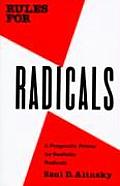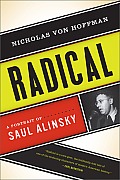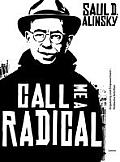 Flip on any media platform, and you won’t have to wait long to hear the name Saul Alinsky. Alinsky was a community
Flip on any media platform, and you won’t have to wait long to hear the name Saul Alinsky. Alinsky was a community  organizer who died over 40 years ago, but to hear Fox tell the tale he has been ruling the Democratic party from beyond the grave ever since. Our Book Spotlight this month offers you the chance to get to know the driving force behind the Maoist Communist Socialist Anti-Constitutional tidal wave that’s sweeping the country by reading the actual words of the Left-Wing Radical Icon in his most famous book…
organizer who died over 40 years ago, but to hear Fox tell the tale he has been ruling the Democratic party from beyond the grave ever since. Our Book Spotlight this month offers you the chance to get to know the driving force behind the Maoist Communist Socialist Anti-Constitutional tidal wave that’s sweeping the country by reading the actual words of the Left-Wing Radical Icon in his most famous book…
Rules For Radicals by Saul Alinsky
First published in 1971, Rules for Radicals is Saul Alinsky’s impassioned counsel to young radicals on how to effect constructive social change and know “the difference between being a realistic radical and being a rhetorical one.” Written in the midst of radical political developments whose direction Alinsky was one of the first to question, this volume exhibits his style at its best. Like Thomas Paine before him, Alinsky was able to combine, both in his person and his writing, the intensity of political engagement with an absolute insistence on rational political discourse and adherence to the American democratic tradition.
The father of modern community organization, Saul Alinsky taught a generation of activists and politicians how to effectively construct social change. In Rules for Radicals, Alinsky writes with passion and intelligence, carefully outlining “the difference between being a realistic radical and being a rhetorical one.” Indispensable since its first publication in 1971, this book continues to inform and inspire all those who believe that political engagement is the key to maintaining America’s democratic tradition.
(You may also be interested in these other books by Saul Alinsky…)
About the Author
Saul Alinsky was born in Chicago in 1909 and educated first in the streets of that city and then in its university. Graduate work at the University of Chicago in criminology introduced him to the Capone gang, and later to Joliet State Prison, where he studied prison life. He founded what is known today as the Alinsky ideology and Alinsky concepts of mass organization for power. His work in organizing the poor to fight for their rights as citizens has been internationally recognized. In the late 1930s he organized the Back of the Yards area in Chicago (the neighborhood made famous in Upton Sinclair’s The Jungle). Subsequently, through the Industrial Areas Foundation which he began in 1940, Mr. Alinsky and his staff helped to organize communities not only in Chicago but throughout the country. He later turned his attentions to the middle class, creating a training institute for organizers. He died in 1972.
BONUS- Book excerpt- Alinsky’s “13 Tactics for Radicals” -BONUS
1. Power is not only what you have, but what the enemy thinks you have.
2. Never go outside the expertise of your people. Doing so will cause insecurity, anxiety and uncertainty.
3. Whenever possible, go outside the expertise of the enemy.
4. Look for ways to increase insecurity and uncertainty. Make the opposition live up to their rules. No one can.
5. Ridicule is man’s most potent weapon. It infuriates the enemy. Their reaction will render them ineffective.
6. A good tactic is one your people enjoy.
7. A tactic that lasts too long becomes a drag. Rabid interest has a relatively short shelf life.
8. Keep the pressure on, find different tactics and actions, and utilize all events as they happen for your purpose.
9. The threat is usually more terrifying than the thing itself.
10. The major premise for tactics is the development of the operations that will maintain a constant pressure upon the enemy.
11. If you push a negative hard and deep enough, it will break through into its counterside. It will become a positive.
12. The price of a successful attack is a constructive alternative.
13. Pick the target, freeze it, personalize it and polarize it. Make everyone believe all the angels are on one side and all the devils on the other side.













